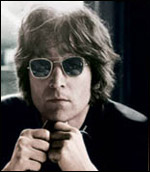40 YEARS AGO: JOHN LENNON GETS LOST AMONG THE ‘WALLS AND BRIDGES’
 Like most of John Lennon‘s solo albums, his fifth, ‘Walls and Bridges,’ came with its fair share of bumps along the way. And like much of Lennon’s work starting around the time the Beatles were working on the “White Album,” many of those bumps were spurred by Yoko Ono. While recording his fourth solo record, ‘Mind Games,’ in 1973, Lennon and Ono split up. His year-and-a-half separation from her became known as Lennon’s Lost Weekend, a fabled period that lasted way longer than a weekend, and included such figures as Ono’s personal assistant (with whom Lennon shacked up), Harry Nilsson and Phil Spector. Lennon was about a year into his break from Ono — and about a month removed from wrapping work on Nilsson’s ‘Pussy Cats’ album — when he began recording ‘Walls and Bridges’ in New York in July 1974. About nine months earlier, Lennon had holed up with legendary producer Spector (who had also assembled the Beatles’ final album, ‘Let It Be,’ from hours of unedited tapes, much to the disappointment of the group’s fans) in hopes of making a record of rock ‘n’ roll oldies.
Like most of John Lennon‘s solo albums, his fifth, ‘Walls and Bridges,’ came with its fair share of bumps along the way. And like much of Lennon’s work starting around the time the Beatles were working on the “White Album,” many of those bumps were spurred by Yoko Ono. While recording his fourth solo record, ‘Mind Games,’ in 1973, Lennon and Ono split up. His year-and-a-half separation from her became known as Lennon’s Lost Weekend, a fabled period that lasted way longer than a weekend, and included such figures as Ono’s personal assistant (with whom Lennon shacked up), Harry Nilsson and Phil Spector. Lennon was about a year into his break from Ono — and about a month removed from wrapping work on Nilsson’s ‘Pussy Cats’ album — when he began recording ‘Walls and Bridges’ in New York in July 1974. About nine months earlier, Lennon had holed up with legendary producer Spector (who had also assembled the Beatles’ final album, ‘Let It Be,’ from hours of unedited tapes, much to the disappointment of the group’s fans) in hopes of making a record of rock ‘n’ roll oldies.
But like many things during Lennon’s Lost Weekend, alcohol sidelined the sessions and Spector left with the tapes (they’d later be revisited for 1975′s ‘Rock ‘n’ Roll’ album). So Lennon fleshed out the new songs he’d been working on since finishing ‘Mind Games’ a year earlier, assembled some Los Angeles session vets, including some string and brass players, and began work on ‘Walls and Bridges.’ And he was all over the place with it, playing around with various styles (pop, rock, R&B, torch), themes (some songs were about Ono, some were about his new love and some were about the Lost Weekend) and intention. Its best songs — ‘Whatever Gets You Thru the Night,’ ‘Bless You,’ ‘Scared,’ ‘#9 Dream’ and ‘Nobody Loves You (When You’re Down and Out)’ — dipped as much into Lennon’s past as they pointed toward his future.
Source: Ultimate Classic Rock



